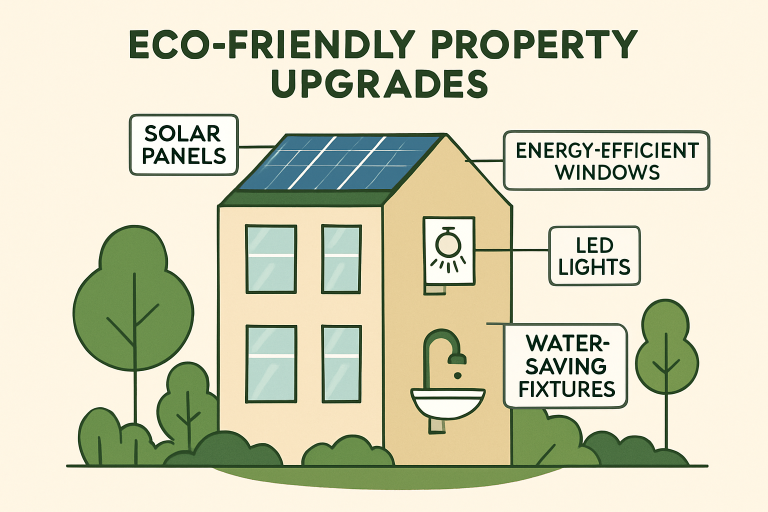Key Takeaways
- Eco-friendly property upgrades can reduce costs and increase property values over time.
- Many sustainable changes have a direct, positive impact on tenant satisfaction and retention.
- Owners and managers do not need to break the bank; many green improvements are affordable and accessible.
- Adopting green practices can align with local incentives and contribute to a healthier environment.
Why Sustainable Property Management Matters
Sustainability in property management isn’t just about “going green”—it’s a smart business strategy that benefits owners, tenants, and local communities alike. As the trend toward eco-conscious living grows, properties that are designed and managed sustainably stand out in the market, enhance tenant attraction, and command higher values. Embracing environmentally responsible choices is especially important for those interested in property management in West Chester, PA. Here, both renters and owners are seeking modern amenities while minimizing their environmental footprint.
By adopting practices that conserve resources, property managers and owners can significantly reduce operating expenses and contribute to a healthier environment. According to the Environmental Protection Agency, incorporating sustainable features into multifamily buildings can lead to increased occupant comfort and long-term cost savings. More importantly, sustainability has become a critical factor in decision-making for many prospective tenants, especially in competitive rental markets.
Energy-Efficient Upgrades That Deliver
Reducing energy consumption is one of the most impactful steps property owners can take. Implementing LED lighting throughout common areas and units yields immediate and long-term savings, as LEDs use up to 75% less energy and last up to 25 times longer than traditional incandescent bulbs: programmable thermostats and smart HVAC controls further lower heating and cooling costs. Upgrading to ENERGY STAR-rated appliances not only cuts electricity use but also appeals to environmentally conscious renters who prioritize energy efficiency in their homes.
Small investments, such as weatherstripping doors and windows, can prevent drafts and reduce unnecessary heating and cooling, thereby enhancing comfort for tenants. Over time, these changes, though modest in upfront costs, pay off through lower monthly bills and higher rates of resident satisfaction.
Water Conservation Strategies
Water-saving features are another essential component of sustainability. Low-flow toilets, aerated faucets, and showerheads use less water without sacrificing performance, resulting in substantial annual savings. Installing smart irrigation systems limits outdoor water waste by adjusting schedules based on weather conditions and soil moisture. Even simple adaptations, such as using mulch and drought-resistant plants, can make landscaping more eco-friendly and easier to maintain.
Proactive leak detection is equally important. Technologies like leak sensors can alert property managers to potential issues before they become costly repairs, preserving resources and preventing further damage. These proactive measures also reduce tenant disruptions and maintenance calls.

Eco-Friendly Materials and Indoor Air Quality
Selecting sustainable and non-toxic materials for upgrades or renovations is crucial for both the planet and indoor health. Low-VOC paints, for instance, release fewer harmful chemicals, making for safer living spaces. Flooring made from recycled content, bamboo, or cork is durable, stylish, and environmentally responsible. Choosing cabinetry and countertops made from rapidly renewable or reclaimed materials not only supports the environment but often comes with unique design benefits.
According to The New York Times, properties with improved indoor air quality experience lower tenant turnover and fewer health complaints, illustrating that sustainability investments extend beyond utility savings—they positively impact day-to-day well-being.
Incentives and ROI for Green Investments
Sustainable property management becomes more attractive with the availability of local and federal incentives, such as tax credits, rebates, and grants, for implementing green solutions. Certification programs such as LEED and ENERGY STAR have also gained popularity, enabling owners to market their properties as eco-friendly and energy-efficient. These certifications can boost a property’s value and appeal by providing third-party validation of environmental performance.
Various studies show that green-certified buildings often rent faster, spend fewer days on the market, and command higher prices than their non-certified peers. As demand for sustainable living grows, so does the return on investment for energy efficiency and other green improvements.
Education and Community Engagement
Successful sustainability initiatives depend on the participation of residents, property managers, and even the broader neighborhood. Providing tenants with educational resources—such as welcome packets that explain recycling, offer utility conservation tips, and highlight community events—can foster greater cooperation and commitment. Organizing workshops or competitions around energy savings further encourages tenants to adopt sustainable habits.
Engaged communities often gain access to shared green spaces, urban gardens, or recreational facilities that promote well-being and social interaction, stretching the benefits of eco-friendly living even further.
Tech and Smart Solutions
Modern technology plays a pivotal role in optimizing resource use. Smart meters provide real-time insights into energy and water consumption, enabling both tenants and managers to make informed decisions. Sensors detect leaks and inefficiencies, allowing maintenance teams to resolve problems before they escalate. App-controlled lighting and HVAC systems streamline operations for managers and grant residents convenient control over their environments.
Recent reporting by Forbes highlights how tech adoption in property management not only saves money but also enhances transparency and convenience—key factors in tenant satisfaction.
Long-Term Benefits for Owners and Tenants
Sustainable upgrades provide lasting value for property owners and tenants alike. Lower utility expenses, fewer maintenance headaches, improved indoor environments, and enhanced marketability add up to stronger returns over time. As sustainability continues to shape the future of real estate, early adoption ensures property owners stay ahead of legislation, tenant demand, and market trends.
Collaborating with experts in property management who understand the value of eco-friendly investments can optimize both financial and environmental returns, paving the way for more resilient and desirable properties well into the future.




Leave a Reply